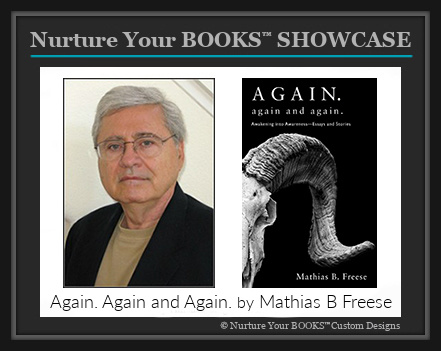A few days ago I received the initial fifteen free copies from the publisher of my new book. Always exciting, fulfilling, intellectually and emotionally nourishing to see one’s new book fill up a box. I reached in for my first copy and relished the delightful rich royal blues of the new cover with a mobius strip as its main symbol and metaphor for the entire book of essays, memoirs and reminiscences, essentially a remembrance of things past.
Usually I carry my new book wherever I go because someone may ask me about it or I may feel I want to share my new effort. [ I associate to my college ring (1962) which I proudly wore after the first few weeks of having it.] And so when I went to a local lab to have my blood drawn for a prostate exam down the line, I began to read and reread selections in the waiting room. I had already spotted some typos which I will remedy down the line, that is to be expected. Consciously I hoped that someone might engage me about what I had spent over a year writing and publishing. I was walking down the street with my newborn in the baby carriage.
Susan, a technician, asked me to come into her room to take a sample of my blood. I placed the book down across the way from the chair I would be in and before she went much further her attention was drawn to the book. She asked about the word “Mobius,” and before I knew it we had engaged one another, especially after I declared I was the author. Elated by the fact that I had written it, that she had met its author, I generally spoke about its contents. Susan told me that in college several of her college profs had commented on her writing talents , urged her to continue in her writing. She chose instead to go into the medical field, but made it clear to me that she had a soft spot for the literary arts. I jokingly suggested, as I have heard about this kind of wish before, that she buy glue and spread it on her rear end, sit down and begin to write, a page a day would give her 365 pages in a year, regardless of the quality of it all.
The conversation opened up a bit more. Since she had chosen science as a career, I mentioned the work of Loren Eiseley, The Immense Journey, a beautiful blend of science and poetic writing, a book I had read in my twenties, to my delight. I told Susan of how unusual he was as a man, scientist and poet. Eiseley had worked as an archaeologist in Egypt. One day he unearthed a child’s mummy. Eiseley chose to stay in that dig with the mummy cradled in his arms until the Egyptian sun went down, for he wanted to imagine what it was like for a mother to hold her nursing child so many centuries ago at dusk. An exceptional response. In my book I cite his work in one of my essays about writing that has impacted upon me, either for style or content.
Drawing my blood seemed a minor item now and that was done expeditiously, and as I left she shared a few facts about her family and I could ascertain that she enjoyed our small conversation. And as I left Susan said, “You’ve made my day.” Mind you, this was 8 A.M. and the day’s drudgery had not really begun, I imagine, for her. So I not only left her blood of my body but something for her mind.
A few days later after I recounted this anecdote to Jane, she wisely suggested that I return and give Susan a copy of my book which I will do, for she gave something to me in turn, that which I desire as a writer –not coin of the realm, but an exchange of ideas, of a sharing, of discussing that which matters to me free of marketing, competition and the American way.
While thinking about my first pleasant sharing of my new book with a complete stranger, it took me three days to think of the name of a famous American art historian, his speciality being the Renaissance. I initially got him confused with Walter Pater, a sterling stylist of pargraphs, but it was not he. The name escaped me, but in discussion about this with Jane it came to mind. I was thinking of Bernard Berenson, born in Lithuania into a Jewish family, the European name was changed here in America and Berenson also converted to Christianity (Oh, Bernie!).
Born in 1865, he lived a very long life and died in Italy (of course) in 1959. His long life is crucial to what I will say here. (His great-great-niece is Marisa Berenson, the actress.) I do not recall where I read what I will retell here or if it was told about Berenson or if it was Berenson writing about himself, but the tale will be shared.
Apparently Berenson was in his nineties and in the square of St. Mark’s in Venice, that famous square in which Kathraine Hepburn meets Rossano Brazzi in Summertime. Sitting down , his hands on top of the knob of his cane, an expresso by his side, Berenson observes, which is his greatest talent, the young adults in frolic in the square, the young women in their periwinkle, charteuse and lilac sun dresses, the young men looking sleek and suave. As he reflects Berenson entertains a fantasy, this scholar-critic who had spent decades writing about the Renaissance, exploring the great museums of the world, trying to fathom the genius of Michelangelo’s David and his Moses, Raphael and DaVinci, the architectural wonders of Florence and Sienna.
It comes to Berenson’s mind that he wanted to invite some of the young adults to his table, to express to them how he wishes to make a trade. He would give them gold pieces, sufficient for a month’s stay in Venice, enough for lodging and food and in return for that, he would ask these young people who were so carefree to give him a few days of their lives. His thinking was not bizarre, for he felt that they would not miss at this stage in their lives a few days whereas he lived day by day at the end of his life. Dawns were not as frequent now as all the sunsets he had lived.
Essentially he would share with these young people, although they could sympathize but not really empathize with his desires, that by having a few more days he was not greedy for additional days to be lived. Oh, no. He wanted some days to revisit a few of the great art treasures of the world, to see the Mona Lisa once more, or a Renaissance church. And for that remembrance gold had no meaning for him, but time had a great deal to do with it.
You may argue that Berenson revealed a greed of a kind, that he would have short-changed the youth whether or not they realized his intent; but there is a scent to this anecdote which touches upon my new book. For I wish to share my book, encounter a human being who can respond, for I am not into selling it so much as to giving it away in a sense. To talk about my book, to hear opinions and judgments about it does not frighten me, because I wrote it for all kinds of reasons, essentially to partake in the community of shared ideas, worth so much more to me than marketing it.
So, in a way, like Berenson, Susan gave me something that was not elicited from her, but purely shared or volunteered from her inner self. You know that is a kind of “book” in itself. And neither one of us exchanged gold pieces.






2 responses to “On Having and Holding This Mobius Strip of Ifs”